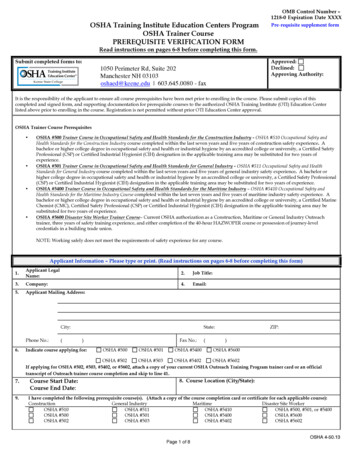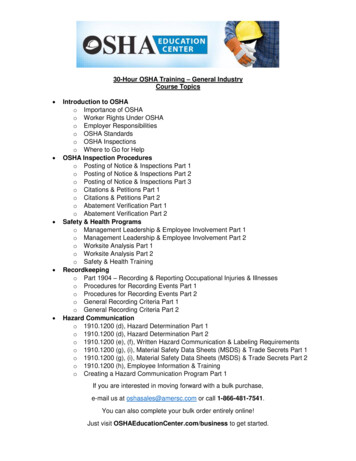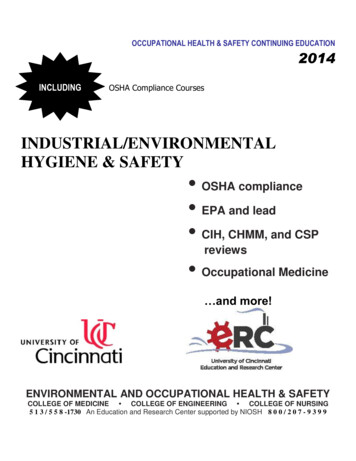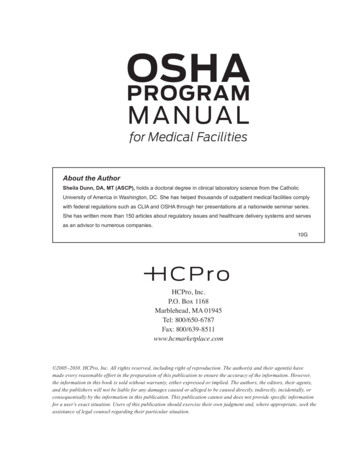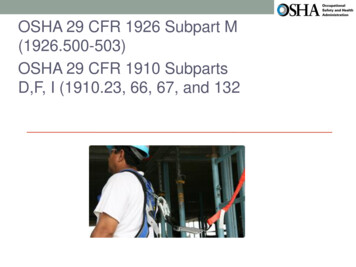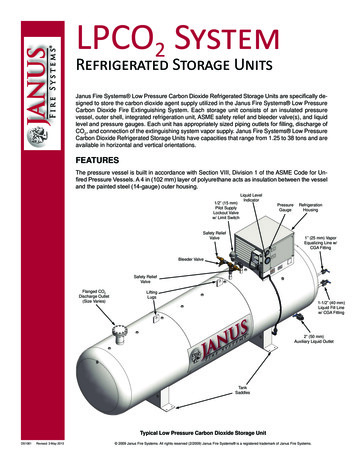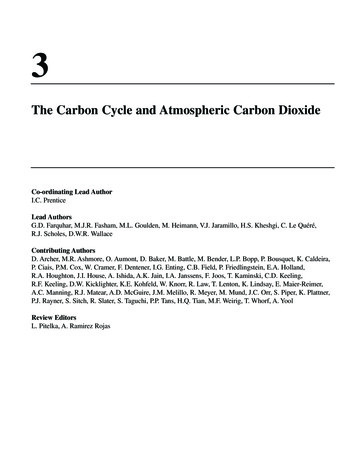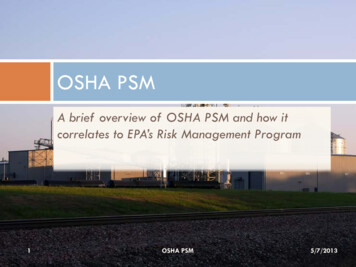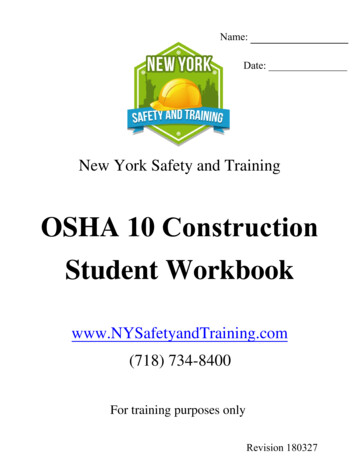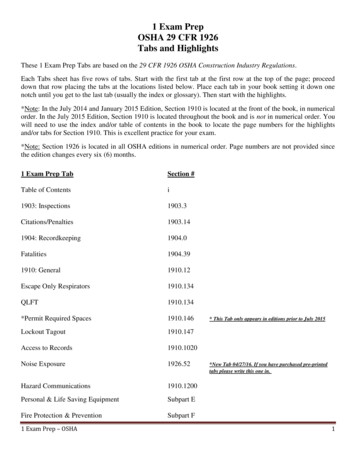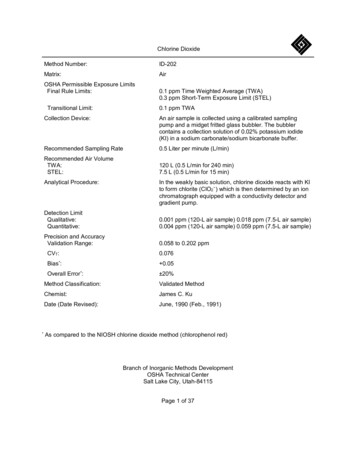
Transcription
Chlorine DioxideMethod Number:ID-202Matrix:AirOSHA Permissible Exposure LimitsFinal Rule Limits:Transitional Limit:0.1 ppm TWACollection Device:An air sample is collected using a calibrated samplingpump and a midget fritted glass bubbler. The bubblercontains a collection solution of 0.02% potassium iodide(KI) in a sodium carbonate/sodium bicarbonate buffer.Recommended Sampling Rate0.5 Liter per minute (L/min)Recommended Air VolumeTWA:STEL:120 L (0.5 L/min for 240 min)7.5 L (0.5 L/min for 15 min)Analytical Procedure:In the weakly basic solution, chlorine dioxide reacts with KIto form chlorite (ClO2 ) which is then determined by an ionchromatograph equipped with a conductivity detector andgradient pump.Detection LimitQualitative:Quantitative:0.001 ppm (120-L air sample) 0.018 ppm (7.5-L air sample)0.004 ppm (120-L air sample) 0.059 ppm (7.5-L air sample)Precision and AccuracyValidation Range:0.058 to 0.202 ppmCVT:0.076Bias*:Overall*0.1 ppm Time Weighted Average (TWA)0.3 ppm Short-Term Exposure Limit (STEL) 0.05Error*: 20%Method Classification:Validated MethodChemist:James C. KuDate (Date Revised):June, 1990 (Feb., 1991)As compared to the NIOSH chlorine dioxide method (chlorophenol red)Branch of Inorganic Methods DevelopmentOSHA Technical CenterSalt Lake City, Utah-84115Page 1 of 37
Commercial manufacturers and products mentioned in this method are for descriptive use only and do notconstitute endorsements by USDOL-OSHA. Similar products from other sources can be substituted.1. IntroductionThis method describes the sample collection and analysis of airborne chlorine dioxide (ClO2). Samplesare taken in the breathing zone of workplace personnel, and analysis is performed by ionchromatography (IC).1.1.HistoryThe previous method used to determine ClO2 in the workplace involved collecting samples in0.01 N sodium hydroxide (8.1). Because this method was also used to collect chlorine (Cl2) andcould not discriminate between the two species, a better method was needed. The scientificliterature contains few articles addressing Cl2 and ClO2 analysis. A method proposed by NIOSHwas a spectrophotometric technique based on the decolorization of chlorophenol red (CPR) byClO2 (8.2). Another method was proposed by the Workers' Compensation Board of BritishColumbia as the N,N-Dimethyl-p-phenylendiaminesulfate (NNDP) method (8.3), This methodwas later evaluated and modified by the National Council of the Paper Industry for Air and StreamImprovement (NCASI) (8.4). The basic technique of this method involves the reaction of Cl2 andClO2 in neutral and acidic solution with iodide to form iodine, and then color comparison using aspectrophotometric technique. Chlorine and chlorine dioxide may be differentiated from oneanother on the basis of their reactivity toward iodine at neutral and acid pH.After reviewing and checking the CPR method, it was found that:1. Chlorine produces a significant positive interference;2. The stock solution used for ClO2 analysis is very difficult to prepare and extremely unstable.A comparison of the CPR and NNDP method indicated a disagreement in results below 0.3 ppmClO2; NIOSH speculated this was due to shortcomings in the iodometric method (8.2).For the volumetric NNDP method, the analysis is a time-consuming process, which uses anunstable reagent (NNDP) for color development (8.4). The method described herein uses acommon analytical technique and is not susceptible to an interference from Cl2. During theevaluation of this method (1988), a paper was published in the literature which describes a similarsampling and analytical approach (8.5); however, the collection solution the authors suggestusing is buffered to a neutral instead of a weakly basic pH.1.2.PrincipleChlorine dioxide is collected in a midget fritted glass bubbler (MFGB), containing 0.02%potassium iodide (KI) in a sodium carbonate/sodium bicarbonate (Na2CO3/NaHCO3) buffersolution. Chlorine dioxide as well as chlorine are trapped and converted to chlorite (ClO2 ) andchloride (Cl ), respectively, in neutral or a weak basic solution according to the following chemicalreactions:ClO2 I ½ I2 ClO2 Page 2 of 37
Cl2 2I I2 2Cl The collected ClO2 (as ClO2 ) is analyzed by IC using a conductivity detector. A gradient pumpis used to facilitate the elution of the iodide ion present in the sampling solution. The amount ofCl2 collected can be estimated as Cl ; however, the evaluation of this method did not include afull validation of the sampling and analysis of Cl2. Therefore, results for Cl2 are only used as ascreening tool. For further information regarding sampling and analysis of Cl2, see OSHA methodno. ID-101.1.3.1.4.Advantages and Disadvantages1.3.1.This method has adequate sensitivity for determining compliance with the OSHA ShortTerm Exposure Limit (STEL) and time weighted average (TWA) permissible exposurelimit (PEL) for workplace exposures to ClO2.1.3.2.The method is simple, rapid, and easily automated.1.3.3.The analysis is specific for ClO2 (determined as chlorite ion, ClO2 ), in the presence ofCl2.1.3.4.This method requires the use of a gradient pump during analysis in order to allow theiodide contained in the collection solution to elute and still have a reasonably shortanalysis time.1.3.5.A disadvantage is the need to prepare standards from a ClO2 stock solution. Thissolution, prepared from technical-grade sodium chlorite (about 80% purity), is unstableand must be standardized monthly.1.3.6.Another disadvantage is the sampling device. Use of impinger collection techniques mayimpose inconveniences. Spillage can occur during sampling, handling, andtransportation to the laboratory.Physical Properties (8.6, 8.7)Chlorine dioxide (CAS No. 10049-04-4):Chemical formulaClO2Molecular weight67.5Specific gravity1.642 at 0 C (liquid)Melting point-59.5 CBoiling point10 CVapor pressure96 KPa (720 mmHg) at 20 CVapor density3.09 g/LSynonymchlorine peroxideOther characteristicsHighly toxic, strong oxidizing agent, soluble and decomposes inwater, dissolves in alkalis forming a mixture of chlorite and chlorate.Explodes when exposed to light, heated, or by reaction with organicmaterials.Page 3 of 37
1.5.Some sources for potential ClO2 exposures are (8.6): 1.6.Bleaching wood pulp, fats, oils, and flour productionRemoving tastes and odors from water suppliesBiocideDisinfectantOdor controlFlour maturing operationsAdditive in swimming poolsToxicologyNote: Information listed within this section is a synopsis of current knowledge of the physiologicaleffects of ClO2 and is not intended to be used as the basis for OSHA policy.Data from human exposures indicate that marked irritation occurs on inhalation of 5 ppm (nolength of exposure specified), and that one death occurred at 19 ppm. Repeated exposures inhumans have been linked to bronchitis and pronounced emphysema. Clinical studies revealedthat the majority of workers who had been exposed for five years to average concentrations ofClO2 below 0.1 ppm, combined with about 1 ppm Cl2, experienced eye and respiratory irritationand slight bronchitis. Some gastrointestinal irritation was also observed in three workers (8.8).2. Range, Detection Limit, and Sensitivity (8.9)2.1.This method was validated over the concentration range of 0.058 to 0.202 ppm. An air volume of120 L and a flow rate of 0.5 L/min were used. Samples were taken for 240 min.2.2.The qualitative detection limit was 0.025 µg/mL or 0.375 µg (as ClO2 ) when using a 15-mLsolution volume. This corresponds to 0.001 ppm ClO2 for a 120-L air volume.2.3.The quantitative detection limit was 0.082 µg/mL or 1.23 µg (as ClO2 ) when using a 15-mLsolution volume. This corresponds to 0.004 ppm ClO2 for a 120-L air volume. A 50-µL sampleinjection loop and a detector setting of 1 microsiemen (µS) were used for both detection limitdeterminations.2.4.The sensitivity of the analytical method was calculated from the slope of a linear working rangecurve (0.5 to 10 µg/mL chlorite). The sensitivity for this curve was 4.07 106 area units per 1µg/mL when using the instrumentation mentioned in Section 6.2.3. Method Performance (8.9)3.1.This method was compared to the NIOSH chlorophenol method for ClO2 (8.2). All results wereobtained using the NIOSH reference method results as known values. Bias and overall errorvalues are reported below as compared to the NIOSH method.3.2.The pooled coefficient of variation (CVT), for samples taken at about 0.5, 1, and 2 times the TWAPEL (0.05 to 0.2 ppm) was 0.076. The method exhibited slight positive bias ( 0.05) for thisconcentration range. The overall error was within acceptable limits ( 25%) at 20%.Page 4 of 37
3.3.The CV2 (pooled) for samples taken in the range of 0.028 to 0.33 ppm (about 0.3 to 3 times theTWA PEL) was 0.072. The method exhibited a slight positive bias ( 0.033) and overall error wasacceptable at 18% for this broader concentration range.3.4.The collection efficiency at 0.2 ppm ClO2 was 100%. Samples were collected at a generatedconcentration of 0.202 ppm ClO2 for 240 min.3.5.A breakthrough test was performed at a concentration of 0.33 ppm ClO2. No breakthrough wasfound for a sampling time of 240 min at an average sample flow rate of 0.5 L/min. Under thesame conditions, for a concentration of 0.67 ppm, the average breakthrough of ClO2 into a secondimpinger was 9.1%. At a flow rate of 1 L/min, about 10% breakthrough occurred after 90 min ata concentration of approximately 0.35 ppm ClO2.3.6.Samples can be stored at normal (20 to 25 C) laboratory conditions for at least 96 days. Resultsof samples analyzed after 96 days were still within 10% of the mean of samples analyzed afterone day of storage. Samples were stored unprotected from light on a laboratory bench.4. Interferences4.1.Any compound having the same retention time as chlorite, when using the operating conditionsdescribed, is an interference.4.2.Interferences may be minimized by changing the eluent concentration and/or pump flow rate, orby using concentration gradient techniques.4.3.Contaminant anions normally found in the workplace, such as nitrate (NO3 ), sulfate (SO42 ), andphosphate (HPO42 ), do not interfere. However, very large amounts ( 100 µg/mL) of Cl - mayinterfere with the determination of ClO2. The possibility of collecting this quantity of Cl in theworkplace is minimal.4.4.Particulate chloride contamination will present a positive interference for the screeningdetermination of Cl2. Care must be exercised to not contaminate the collection solutions withchloride salts if screening for Cl2 is desired.4.5.When other compounds are known or suspected to be present in the air, such information shouldbe transmitted with the sample.4.6.Altering the pH of the collection solution to more acidic conditions will alter the reaction of ClO2to ClO2. If strongly acidic gases are present in the sampled atmosphere and convert the bufferto an acidic solution, the reaction will not proceed in the fashion mentioned in Section 1.2. Thefollowing reaction would most likely occur:ClO2 4H 4 I 2I2 2H2O Cl The collection solution should have adequate buffering capacity for most industrial hygienemonitoring situations; however, sampling times should be decreased to maintain slightly basicconditions if sampling in the presence of large concentrations of acid gases (i.e. sulfur dioxide).The pH of the solution can also be measured with pH paper after sampling to determine if thecollection solution has become acidic. If acidic, discard the sample and resample using shortersampling times.Page 5 of 37
5. Sampling5.1.Equipment and Reagents5.1.1.Calibrated personal sampling pumps capable of sampling within 5% of therecommended flow rate of 0.5 L/min.5.1.2.Midget fritted glass bubblers (MFGBs) (25-mL, part no. 7532, Ace Glass Co., Vineland,NJ).5.1.3.Shipping vials: Glass scintillation vials, 20-mL, with Teflon-lined caps.5.1.4.A stopwatch and bubble tube or meter - for pump calibration. Place a calibration MFGBcontaining 10 to 15 mL of collection solution in-line during flow rate calibration of eachpump.5.1.5.Various lengths of polyvinyl chloride (PVC) tubing are used to connect the MFGBs topumps.5.1.6.Buffer solution (1.5 mM Na2CO3/1.5 mM NaHCO3):Dissolve 0.636 g Na2CO3 and 0.504 g NaHCO3 in 4.0 L of deionized water.5.1.7.Collection solution:Dissolve 0.2 g KI in 1.0 L of buffer solution.5.2.Sampling Procedure5.2.1.Place 15 mL of collection solution in a MFGB, and then connect the bubbler to acalibrated sampling pump using PVC tubing. Position the MFGB in the breathing zoneof the employee.5.2.2.For STEL determinations, collect the sample at a flow rate of 0.5 L/min and a samplingtime of at least 15 min. For TWA samples, an air volume of 120-L is recommended at0.5 L/min. Take enough samples to cover the work shift being monitored.5.2.3.After sampling, transfer the bubbler solution into a 20-mL glass scintillation vial. Rinsethe bubbler with 2 to 3 mL of unused collection solution and transfer the rinsings into thesample vial. Place the Teflon-lined cap tightly on the vial and seal the cap with vinyl orwaterproof tape to prevent leakage during shipment.6. Analysis6.1.Precautions6.1.1.Refer to instrument and standard operating procedures (SOP) for proper operation(8.10, 8.11).6.1.2.Observe laboratory safety regulations and practices.6.1.3.Sulfuric acid (H2SO4) can cause severe burns. Wear protective gloves, lab coat, andeyewear when using concentrated H2SO4.Page 6 of 37
6.2.Equipment6.2.1.Ion chromatograph (Model 4000i or 4500i with a concentration-gradient pump, Dionex,Sunnyvale, CA) equipped with a conductivity detector.6.2.2.Automatic sampler (Model AS-1, Dionex) and sample vials (0.5 mL).6.2.3.Laboratory automation system: Ion chromatograph interfaced to a data reduction system.6.2.4.Anion separator column with precolumn (Model HPIC-AS4A and AS4G, Dionex).6.2.5.Anion suppressor (Model AMMS-1 micro-membrane suppressor, Dionex).6.2.6.Disposable syringes (1 mL) and filters.(Note: Some syringe pre-filters are not cation- or anion-free. Tests should be done withblank solutions first to determine suitability for the analyte being determined).6.3.6.2.7.Miscellaneous volumetric glassware: Micropipettes, burette, volumetric flasks, graduatedcylinders, and beakers.6.2.8.Analytical balance (0.01 mg).Reagents - All chemicals should be at least reagent grade (Note: Sodium chlorite may only becommercially available as technical grade) Sodium bicarbonate (NaHCO3) Sodium carbonate (Na2CO3) Potassium iodide (KI) Sodium chloride (NaCl) Sulfuric acid6.3.1.Eluent 1: Deionized water (DI H2O) with a specific conductance of less than 10 µS.6.3.2.Eluent 2 (10 mM Na2CO3):Dissolve 2.12 g Na2CO3 in 2.0 L of DI H2O.6.3.3.Eluent 3 (10 mM NaHCO3):Dissolve 1.68 g NaHCO3 in 2.0 L of DI H2O.6.3.4.Buffer solution (1.5 mM Na2CO3/1.5 mM NaHCO3):Dissolve 0.636 g Na2CO3 and 0.504 g NaHCO3 in 4.0 L of DI H2O.6.3.5.Collection solution:Dissolve 0.2 g KI in 1.0 L of buffer solution.6.3.6.Regeneration solution (0.02 N H2SO4):Place 1.14 mL concentrated H2SO4 into a 2-L volumetric flask which contains about 500mL DI H2O. Dilute to volume with DI H2O.Page 7 of 37
6.3.7.Chloride stock standard (1,000 µg/mL):Dissolve 1.6479 g dried NaCl and dilute to the mark in a 1-L volumetric flask with DI H2O.6.3.8.Chloride standards (100, 10, and 1 µg/mL):Perform serial dilutions of the 1,000 µg/mL chloride stock standard with collectionsolution. Prepare weekly. [Note: Prepare only if necessary. These standards are onlyused to screen Cl2 (as Cl ) concentrations.]6.3.9.Chlorite stock standard (1,000 µg/mL):Dissolve in a 1-L volumetric flask approximately 1.7 g sodium chlorite (NaClO2) in 500mL DI H2O. Dilute to the mark with DI H2O. Wrap the volumetric flask with aluminum foiland store in a refrigerator at about 4 C. This solution must be standardizedmonthly as described in Section 6.4.1.6.3.10. Chlorite standard (100 µg/mL). Dilute 10 mL of the 1,000 µg/mL chlorite stock standardto 100 mL with collection solution. Prepare monthly.6.3.11. Chlorite standard (10 µg/mL). Dilute 10 mL of the 100 µg/mL chlorite stock standard to100 mL with collection solution. Prepare weekly.6.3.12. Chlorite standard (1 µg/mL). Dilute 10 mL of the 10 µg/mL chlorite stock standard to 100mL with collection solution. Prepare weekly.6.3.13. Reagents for standardizing the chlorite stock standard solution:Note: If a 0.1 N ( 0.5% variation) sodium thiosulfate solution traceable to a primarystandard is unavailable, any laboratory-prepared sodium thiosulfate solutions must bestandardized according to procedures listed in reference 8.12. Standardize any sodiumthiosulfate solution has aged significantly.1. Sodium thiosulfate solution (Na2S2O3), 0.1 N, traceable to a primary standard (Cat.No. SS368-1, Fisher Scientific, Pittsburgh, PA). Any expiration date must be adhered to.This solution can be prepared and standardized according to procedures inreference 8.12.2. Sulfuric acid (H2SO4), concentrated.3. Sulfuric acid, dilute.Slowly and cautiously add 40 mL of concentrated H2SO4 to a 200-mL volumetric flaskwhich contains 150 mL DI H2O. Allow to cool, then dilute to volume with DI H2O.4. Potassium iodide (KI).5. Starch indicator solution, (1% w/v): Gradually add about 5 mL of DI H2O to 1 g solublestarch, with stirring, until a paste is formed. Add the paste to 100 mL of boiling DI H2O.Allow to cool, then add 5 g KI and stir until the KI is dissolved. Prepare a fresh solutionfor each standardization. Alternatively, a commercial indicator can be used (Starchindicator, Cat. No. 8050, Ricca Chemical Co., Arlington, TX).Page 8 of 37
6.4.Standard Preparation6.4.1.Standardization of chlorite stock solution. (Note: This procedure is adapted from thosefound in reference 8.12)1. Add 10 mL of dilute H2SO4 into a 125-mL Phillips beaker which contains 20.0 mL ofNaClO2 stock solution (1,000 µg/mL, from Section 6.3.9).2. Add 1 g of KI and 40 mL of DI H2O.3. Titrate with standardized 0.1 N Na2S2O3 until a color change to a light straw color isachieved.4. Add 2 mL of 1% starch indicator. A blue color should appear.5. Titrate again with 0.1 N Na2S2O3 until the blue color completely disappears.6. For blank sample(s), repeat steps 1 through 5 except use 20.0 mL DI H2O instead of20.0 mL of the NaClO2 stock solution.7. Calculate µg/mL chlorite as follows:where:(𝐴𝐴 ��� 𝑚𝑚𝑚𝑚 ClO2 A mL of the standardized Na2S2O3 solution required to titrate the sampleB mL of the standardized Na2S2O3 solution required to titrate the blankC normality of the standardized Na2S2O3 solution (meq/mL)D (16.875 mg/meq ClO2 )(1,000 µg/mg) 16.875 103 µg/meq of ClO2 6.4.2.E mL of ClO2 used 20 mLWorking standard preparation:1. Prepare chlorite (or chloride, or a chlorite and chloride mixture) working standards inthe ranges specified below:Working std Standard Solution lreadyprepared in Section 6.3.Page 9 of 37
2. Pipette appropriate aliquots of standard solutions (prepared in Section 6.3) into 10mLvolumetric flasks and dilute to volume with collection solution.6.5.6.6.6.4.3.Pipette a 0.5- to 0.6-mL portion of each standard solution into separate automaticsampler vials. Place a 0.5-mL filter cap into each vial. The large exposed filter portion ofthe cap should face the standard solution.6.4.4.Prepare a reagent blank from the collection solution.Sample Preparation6.5.1.Carefully transfer sample solutions from the 20-mL glass scintillation vials into 25-mLgraduated cylinders. Measure and record the sample solution volumes.6.5.2.If the sample solutions contain particulate, remove the particles using a pre-filter andsyringe. Fill the 0.5-mL automatic sampler vials with sample solutions and push a 0.5mL filter cap into each vial.6.5.3.Load the automatic sampler with labeled samples, standards and blanks.Analytical Procedure6.6.1.Set up the ion chromatograph in accordance with the SOP (8.10).Typical operating conditions for a Dionex 4000i or 4500i with an automated sampler arelisted below.Gradient pumpEluent 1:DI H2OEluent 2:10.0 mM Na2CO3Eluent 3:10.0 mM NaHCO3Pump pressure:approximately 900 psiFlow rate:2 mL/minTimeFlowEluentminmL/min %1 %2 %30.02.070030Initialconditions0.12.070030Inject 070030Page 10 of 37Comments**
*Gradient change in eluent concentration from 3.1 to 11.1 min is performed to facilitateelution of iodide present in the collection solution.** Gradient return in eluent concentration to initial analytical conditions.Column & Sample InjectionColumn:HPIC-AS4AColumn temperature:ambientSample injection loop:50 µLChromatogramRun time:18 minPeak retention time:6.6.2.ClO2 approximately 2 minCl approximately 3 minFollow the SOP (8.10) for further analytical instructions.7. Calculations7.1.After the analysis is completed, the peak areas and heights can be retrieved using a variety ofmethods or programs. Obtain hard copies of chromatograms from a printer. A chromatogram ofa mixed standard of 5 µg/mL ClO2 and 0.5 µg/mL Cl is shown in Figure 1.7.2.Prepare a concentration-response curve by plotting the concentration of the standards in µg/mLversus peak areas or peak heights. Determine the concentration (µg/mL) of each sample bycomparing the area or height to the curve. Blank correct all samples as shown:where:𝑢𝑢𝑢𝑢𝑢𝑢 Analyte (𝑆𝑆)(𝑆𝑆𝑆𝑆) (𝐵𝐵𝐵𝐵)(𝐵𝐵𝐵𝐵𝐵𝐵)µgC Analyte Corrected amount (µg) in the sample solutionS µg/mL sample (from curve)SV Sample solution volume, mL (from Section 6.5.1).BL µg/mL blank (from curve)7.3.BLV Blank solution volume, mL (from Section 6.5.1).The concentration of ClO2 and Cl2 in each air sample is expressed in ppm.𝑝𝑝𝑝𝑝𝑝𝑝 ClO2 𝑝𝑝𝑝𝑝𝑝𝑝 Cl2 𝑢𝑢𝑢𝑢C Analyte molar volumeair volume molecular weight𝑢𝑢𝑢𝑢C Analyte molar volume GFair volume molecular weightPage 11 of 37
whereµgC Analyte Corrected amount (µg) in the sample solutionmolar volume 24.45 (25 C and 760 mmHg)molecular weight for ClO2 67.5molecular weight for Cl2 71.0Gravimetric Factor (GF) 2*7.4.Note: Results for Cl2 are used for screening purposes only.Reporting ResultsReport results to the industrial hygienist as ppm chlorine dioxide. Results determined forexposure to chorine may be used as information to the industrial hygienist. Additional samplingfor chlorine may be recommended using OSHA method no. ID-101.8. References8.1.Occupational Safety and Health Administration Analytical Laboratory: Chlorine Dioxide(Tentative), Internal Document. Salt Lake City, UT, 1971 (unpublished).8.2.National Institute for Occupational Safety and Health: Methods Development for Samplingand Analysis of Chlorine, Chlorine Dioxide, Bromine, and Iodine - Research Report for ChlorineDioxide by W.K. Fowler and H.K. Dillon. Birmingham, AL: Southern Research Institute (Contractno. 210-80-0067), 1982.8.3.Laboratory Services, Worker's Compensation Board of British Columbia: Chlorine Dioxidein Air (Analytical Method No. 0350). Vancouver, B.C., Canada: Worker's Compensation Board ofBritish Columbia, Draft Copy, 1982.8.4.National Council of the Paper Industry for Air and Stream Improvement, Inc.: A LaboratoryInvestigation of an Iodometric Method for Determining Chlorine and Chlorine Dioxide in Pulp andPaper Industry Workplace Atmospheres (Technical Bulletin No. 409). New York: NCASI,September 1983. Also: Development and Laboratory Evaluation of Improved IodometricMethods for Determining Chlorine and Chlorine Dioxide in Pulp and Paper Industry WorkplaceAtmospheres (Technical Bulletin No. 521). April, 1987.8.5.Bjorkholm, E., A. Hultman, and J. Rudling: Determination of chlorine and chlorine dioxide inworkplace air by impinger collection and ion-chromatographic analysis. J Chromatogr. 457: 409414 (1988).8.6.Hawley, G.G.:The Condensed Chemical Dictionary. 11th ed. New York: Van Nostrand ReinholdCo., 1987.8.7.Weast, R.C., ed.: CRC Handbook of Chemistry and Physics. 59th ed. Boca Raton, FL: CRCPress, Inc., 1979.8.8."Chlorine Dioxide" Federal Register 54:12 (19 Jan. 1989). p. 2508.8.9.Occupational Safety and Health Administration Technical Center: Chlorine Dioxide BackupData Report (ID-202). Salt Lake City, UT. Revised 1991.Page 12 of 37
8.10. Dionex Corporation: 4000i and 4500i Ion Chromatograph Operation and Maintenance Manual.Sunnyvale, CA: Dionex Corporation, 1988.8.11. Occupational Safety and Health Administration Technical Center: Ion ChromatographyStandard Operating Procedure. Salt Lake City, UT. In progress (unpublished).8.12. American Society for Testing and Materials: Standard Recommended Practices forApparatus, Reagents, and Safety Precautions for Chemical Analysis of Metals (Annual Book ofASTM Standards, Part 12, E-50). Philadelphia, PA: American Society for Testing and Materials,1978.Chromatogram of a Mixture of 5 µg/mL ClO2 and 0.5 µg/mL Cl PEAK NUM RET TIME PEAK 78chloritechlorideFigure 1Page 13 of 37AREAHEIGHT1.028e 007 11799721.696e 005 180791.482e 005 197952.222e 007 21746924.259e 006 3432912.713e 007 4286391.569e 007 16780836.284e 006 9604003.672e 0076410
Backup ReportIntroductionThe procedure for collection and analysis of air samples for chlorine dioxide (ClO2) is described in OSHAMethod No. ID-202 (9.1). Chlorine dioxide and chlorine (Cl2) are both collected in a midget fritted glassbubbler (MFGB), containing 0.02% potassium iodide (KI) in a weak buffer. These two species are trappedand converted to chlorite (ClO2-) and chloride (Cl-), respectively, based on the following chemical reactions:ClO2 I- ½ I2 ClO2Cl2 2I- I2 2Cl-These reactions occur in neutral or weakly basic solutions. The collection solution used for this methodcontains 0.02% KI in 1.5 mM sodium carbonate and 1.5 mM sodium bicarbonate. The collected chlorinedioxide (as ClO2 ) and chlorine (as Cl ) are then analyzed by ion chromatography (IC).This method has been validated for a 120-L, 240-min sample based on a flow rate of 0.5 L/min. The methodvalidation was conducted near the OSHA time weighted average (TWA) permissible exposure limit (PEL)of 0.1 ppm and consisted of the following experiments and summaries:1. An analysis of 18 samples (6 samples at each test level).2. A sampling and analysis of 18 samples (6 samples at each test level, 50% RH) collected fromdynamically generated test atmospheres. Additional samples at other test levels and humiditieswere also taken.3. A determination of the sampling media collection efficiency at 0.2 ppm (2 times the TWA PEL).4. A determination of breakthrough.5. An evaluation of room temperature storage stability for 12 collected samples.6. A determination of any significant effects on results when sampling at different humidities.7. A determination of the qualitative and quantitative detection limits.8. A determination of sampling efficiency of the collection solution when sampling a mixture ofdynamically generated ClO2 and Cl2.9. Summary.All theoretical (known) concentrations of generated test atmospheres were determined using the NIOSHchlorophenol red (CPR) method for ClO2 (9.2). All sampling tests performed were conducted side-by-sidewith IC and CPR samples being taken and analyzed using the conditions recommended in their methods(9.1, 9.2). The CPR method was slightly modified for these experiments. The chlorite stock solution wasprepared without the addition of acetic anhydride and the solution was standardized using a primarystandard instead of molar absorbance as mentioned in the NIOSH method. The unknown potential effecton the IC determinations from having small amounts of acetic anhydride in the standards and not in thesamples was one reason for its exclusion. The chlorite stock solution was standardized using the procedureadvocated by the National Council of the Paper Industry for Air and Stream Improvement (NCASI) (9.3)and the acetic anhydride may also have presented an effect on this titration. This standardization was feltto be more accurate than the NIOSH approach.All results were calculated from concentration-response curves and statistically examined for outliers. Inaddition, the analysis (Section 1) and sampling and analysis results (Section 2) were tested for homogeneityof variance. Possible outliers were determined using the Treatment of Outliers test (9.4). Homogeneity ofPage 14 of 37
variance was determined using the Bartlett's test (9.5). Statistical evaluation was conducted according toInorganic Methods Evaluation Protocol (9.6). Overall error (9.6) was calculated using the equation:Overall errori ( biasi 2CVi) 100% (95% confidence level)Where i is the respective sample pool being examined.1. Analysis1.1.Preparation of Known ClO2 ConcentrationsSamples were prepared by adding known amounts of sodium chlorite (NaClO2) solution into 25mL volumetric flasks containing collection solution. Technical-grade NaClO2 was used to preparethe stock solution and was standardized according to the procedure described in the method(9.1).1.2.Analysis of Spiked SamplesAnalysis was performed using an ion chromatograph equipped with a conductivity detector (9.1).1.3.Determination of Analytical Method Recovery (AMR)Recoveries were compared to the known amounts of chlorite spikes and are presented in Table1. All results passed the Test for Outliers and the Bartlett's test. The AMR was 97.8% and theanalytical precision (CV1 pooled) was 0.024.2. Sampling and Analysis2.1.Preparation and Collection of Known Generated Samples2.1.1.Dynamic generation systemA diagram of the generation system is shown in Figure 1. The system consists of fiveessential elements: A flow-temperature-humidity control system (Miller-Nelson ResearchInc., Monterey, CA, Model HCS-301) which is used for air flow control and conditioning,a ClO2 or ClO2 Cl2 mixture vapor generating system, a mixing chamber, and samplingmanifold. All generation system fittings and connections were Teflon. A
OSHA Permissible Exposure Limits Final Rule Limits: 0.1 ppm Time Weighted Average (TWA) 0.3 ppm Short-Term Exposure Limit (STEL) Transitional Limit: 0.1 ppm TWA Collection Device: An air sample is collected using a calibrated sampling pump and a midget fritted glass bubbler. The bubbler
